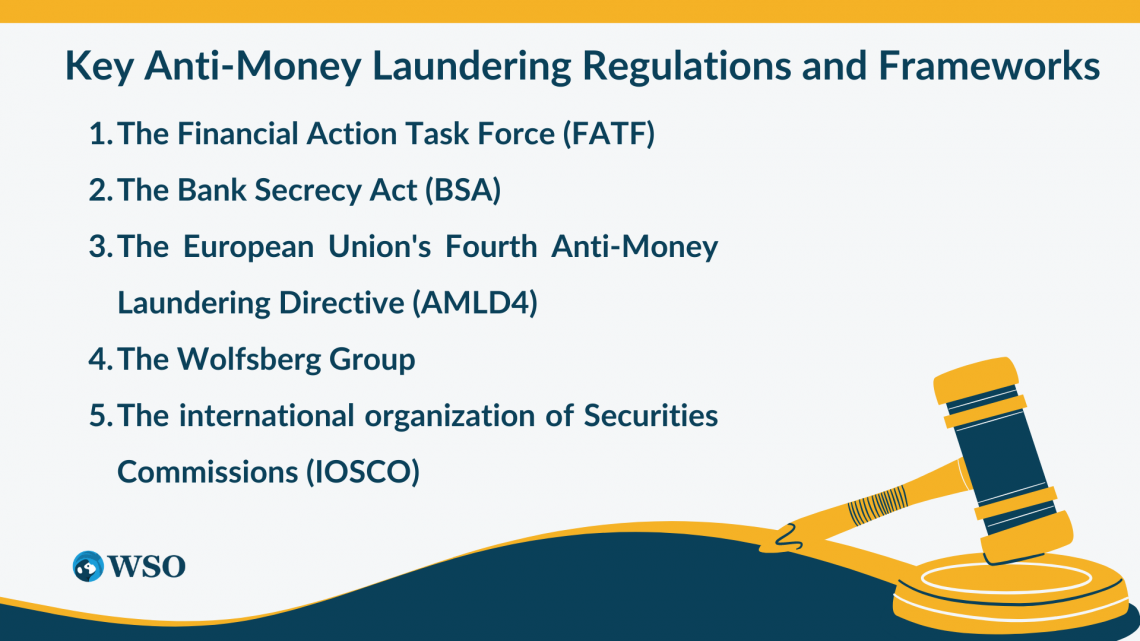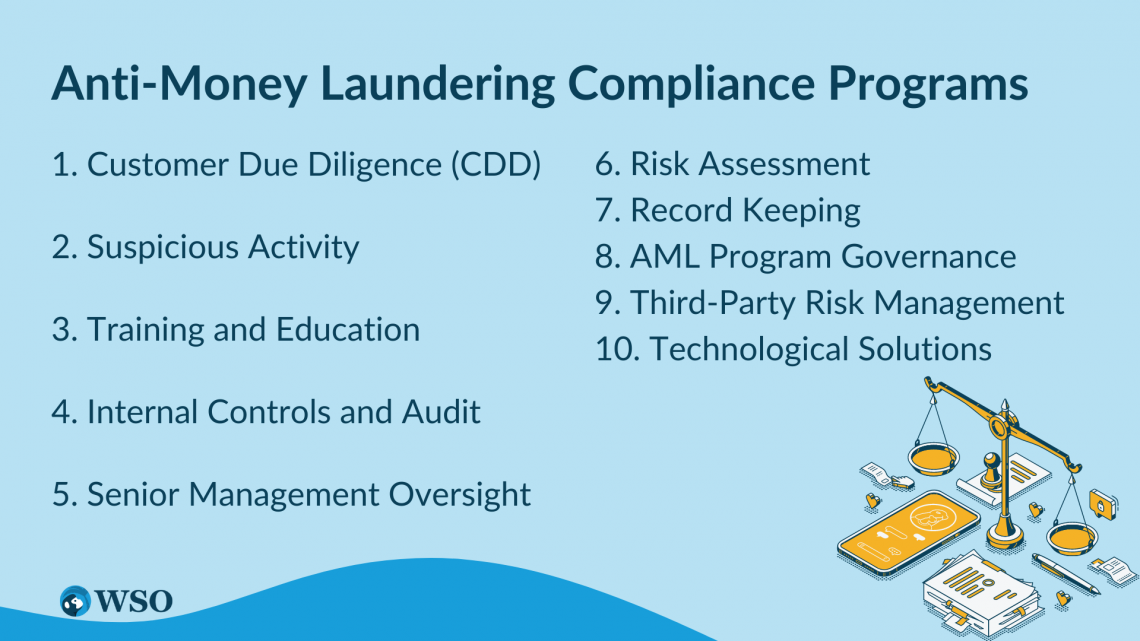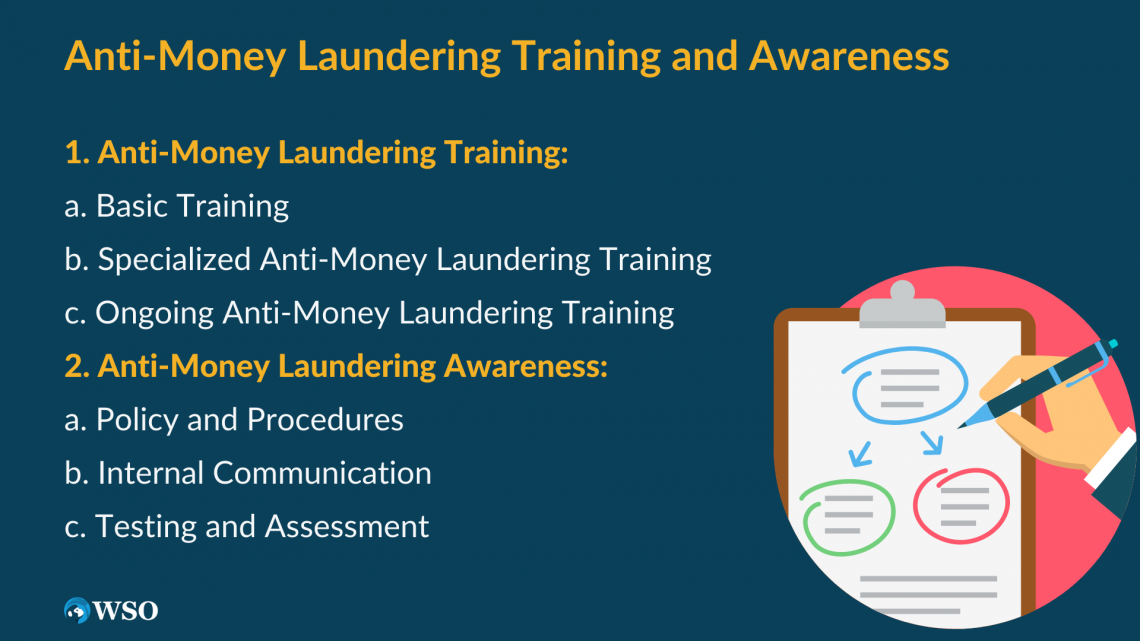Anti-Money Laundering
Anti-money laundering refers to a set of laws, rules, and methods put in place by governments and financial institutions to stop money laundering
Let's learn more about money laundering before going on to our primary subject. So basically, what is money laundering? And how it works?

Money laundering is a crime that entails making the proceeds of unlawful activity seem legitimate to conceal them. In simple language, we can say that converting black money into white money is an illegal procedure.
To become aware of and prevent cash laundering operations, financial establishments and other organizations develop anti-money laundering rules, strategies, and laws. Also, some groups of people may use institutions or other businesses for their laundering purpose.
This article will thoroughly explain anti-money laundering methods and systemic mitigation strategies. So without any ado, let's dive into our main topic, which will provide you with wide insight into AML.
Anti-money laundering refers to a set of laws, rules, and methods by governments and financial institutions to stop and trace the unlawful exercise of hiding the resources of funds obtained through criminal activity, including drug trafficking, terrorism, and corruption.
Because criminals attempted to take gain of flaws in online systems and their use of cryptocurrencies for money laundering, the enlargement of digital economic transactions has additionally raised the call for AML safeguards.
AML procedures guarantee that financial institutions like banks follow legal standards and take the required steps to detect and report suspicious activities. Here, we have to remember that government always tries to mitigate the laundering procedures.
A country's government takes strict action against those businesses and organizations that launder money.
They apply some measures in their activity to find these types of institutions. These measures include customer due diligence, transaction monitoring, and reporting suspicious activities to authorities.
Also, to find if any individual is related to this activity, they proceed with the due diligence of business owners. Customer due diligence includes confirming clients' identities, evaluating the likelihood of money laundering, and determining why transactions occur.
Transaction monitoring involves analyzing transactions to identify suspicious patterns, such as large or frequent cash deposits or transfers to high-risk countries.
- Anti-money laundering regulations and frameworks are essential to prevent financial crime and terrorist financing.
- Each financial organization has to follow the regulations and frameworks to avoid and prevent money laundering and terrorist funding activity.
- The AML compliance program is critical to anti-money laundering regulations and frameworks.
- The compliance program must encompass the improvement of internal policies, techniques, and controls to prevent money laundering and terrorist financing.
- Customer due diligence (CDD), knowing your customer (KYC), and suspicious activity reporting (SAR) are important components of the compliance program.
- AML training and awareness ensure employees understand their responsibilities under regulations and frameworks.
- Blockchain, AI, and other revolutionary technologies can potentially increase compliance.
- Fighting money laundering and terrorist funding requires effective cooperation between financial institutions, regulatory bodies, and law enforcement organizations.
The Need for Anti-Money Laundering Measures
Money laundering is a process that involves concealing the true origin of illegally obtained funds to make them appear legitimate.

This is often done by funneling the money through various transactions and accounts to hide its source and avoid detection by law enforcement agencies. The global issue of money laundering supports illegal behavior, including drug trafficking, terrorism, and corruption.
National governments worldwide have put their efforts into various measures to stop the AML practice.
The need for these measures is essential for countries going through an economic crisis and many more illegal and fraudulent activities on their country's border.
By forcing financial institutions, including banks and money transfer services, to adhere to particular processes to authenticate the identification of customers and monitor their transactions for suspicious behavior, AML regulations strive to identify and prevent money laundering.
There are several reasons why AML measures are necessary. First, we will review some important reasons to determine why they need AML.
| Key Reasons | Explanation |
|---|---|
| Risk of Money Laundering | Money laundering poses a significant risk to the integrity of the monetary system. |
| Undermining the Rule of Law | Criminal organizations use money laundering to fund unlawful operations like terrorism, human trafficking, and drug smuggling, undermining the rule of law. |
| Economic Consequences | Money laundering has significant economic consequences, including creating an uneven playing field and undermining legitimate businesses. |
| Unfair Competition | Criminals can compete unfairly by using money laundering to boost prices and create asset bubbles in markets like real estate. |
| Asset Price Bubbles | Money laundering can cause unbalanced markets by creating bubbles in asset classes like real estate. |
|
Reputation Protection |
Financial institutions must implement measures to safeguard their reputation and demonstrate their commitment to preventing money laundering and protecting their customers' assets. |
| Penalties for Violations | Violations of AML laws can result in hefty penalties, legal action, and reputational harm. |
| Demonstrating Commitment | By implementing robust measures, financial institutions can demonstrate their commitment to preventing money laundering and protecting their customers' assets. |
| National Security | Criminal organizations and terrorists often use money laundering to finance their operations, and measures to prevent it are essential for national security. |
| Disrupting Funding | By preventing money laundering, governments can disrupt the funding of criminal and terrorist organizations and protect their citizens from harm. |
The purpose and need of this system are very helpful for the growing legal organizations which follow the rules and regulations of the country's government.
They are essential for safeguarding national security, deterring crime, defending lawful enterprises, and defending the global financial system.
Key Anti-Money Laundering Regulations and Frameworks
Certainly, the purpose of the AML system is necessary if a country wants to grow without any setbacks. However, the need for every country is also based on the illegal activities inside their border.

So now we will go through some laws and regulations which are helpful for a country to mitigate the money laundering problem.
Regulations and frameworks against AML are crucial for stopping and identifying illegal acts, including financing terrorism and money laundering. The following points will cover the main laws and frameworks in force to prevent financial crimes.
These rules and regulations provide a workplace and environment where the government easily subdues these criminal activities.
One fact about the AML frameworks mentioned is that they constantly evolve to keep up with changing technology and emerging threats. This indicates that these frameworks' dynamic gear is always being refined to evolve to new risks and challenges within the financial system.
1. The financial action task force (FATF)
We must understand that FATF aims to provide and develop the global guidelines and requirements for AML and counter-terrorist financing (CFT). Its 40 Recommendations have been adopted by more than 200 countries and jurisdictions worldwide.
FATF's recommendations include measures to prevent the use of financial systems for money laundering and terrorist financing. These measures include customer due diligence, suspicious transaction reporting, and the freezing of assets of suspected criminals.
Countries that fail to implement these recommendations risk being blacklisted by FATF, which can have significant economic and financial consequences.
2. The Bank Secrecy Act (BSA)
We must remember that if any fraudulent activities occur in a financial or other institution, they must inform the financial crimes enforcement community (FinCEN).
And it is obligatory because these acts come underneath the bank secrecy act (BSA), a federal law of the U.S. The law also requires financial institutions to implement AML programs and maintain records of customer transactions.
BSA compliance is essential for financial institutions operating in the United States. Also, if someone is not complying with the rules and regulations, it might result in massive fines, charges, and other legal actions against those institutions.
3. The European Union's Fourth Anti-Money Laundering Directive (AMLD4)
The European Union's Fourth Anti-Money Laundering Directive (AMLD4) sets out the EU's AML/CFT framework.
The directive requires member states to implement measures to prevent money laundering and terrorist financing, including customer due diligence, risk assessments, and suspicious transaction reporting.
AMLD4 requires member states to establish beneficial ownership registers, which provide transparency about the ownership of companies and other legal entities.
4. The Wolfsberg Group
The Wolfsberg Group is an association of thirteen global banks that develops AML and CFT standards for the financial industry. The group has developed several guidelines and frameworks that help financial institutions implement effective AML programs.
The Wolfsberg Group's guidelines cover customer due diligence, risk assessments, and sanctions compliance. They are common in the financial sector and regarded as best practices for AML observance.
5. The international organization of Securities Commissions (IOSCO)
The international organization of Securities Commissions (IOSCO) is an international body that establishes norms for the law of securities.
Its Mission and Concepts of Financial Instruments Regulation offer a framework for surveillance of the securities markets in a way that encourages the protection of investors and fosters fairness and transparency.

IOSCO's principles also include measures to prevent market manipulation, insider trading, and other forms of financial crime. In addition, the organization works closely with other global organizations, such as FATF, to ensure a coordinated AML/CFT regulation approach.
AML guidelines and procedures are essential for stopping and identifying financial crimes, including money laundering and supporting terrorism.
The important laws and frameworks covered in this article are only a few programs currently being implemented to fight financial crimes.
We can contribute to developing a better and more comfy economic system for everyone by implementing these steps and cooperating worldwide.
Anti-Money Laundering Compliance Programs
The anti-money laundering compliance programs are intended to keep financial institutions from being exploited to assist in money laundering and terrorism funding.

In many countries, these programs are mandated through regulation and are important to a financial enterprise's risk control system.
Policies, practices, and controls for identifying suspicious transactions and reporting them, doing customer due diligence, and keeping an eye out for suspected money laundering and terrorist financing activities are all part of compliance programs.
Financial institutions must use compliance programs as a key weapon to stop money laundering and terrorism funding.
Effective programs require ongoing monitoring, education, training, and senior management oversight to ensure their effectiveness.
Financial institutions can protect themselves and their customers from financial crime risks by implementing and maintaining robust compliance programs.
Now, let us go through the important components of an efficient compliance program:
1. Customer Due Diligence (CDD)
Verifying a customer's identification and determining what risk they provide to a financial organization is known as customer due diligence.
This includes collecting and verifying customer identification information, understanding the purpose of the account, and assessing the customer's source of funds.
2. Suspicious Activity
Monitoring and ReportingThe compliance programs should include monitoring for suspicious activity and reporting it to the relevant authorities.
Financial institutions must have mechanisms for spotting, investigating, and reporting suspicious transactions to the proper regulatory organizations.
3. Training and Education
The compliance programs should include ongoing training and education for employees to ensure they know AML regulations and the risks of money laundering and terrorist financing.

This includes training on customer due diligence procedures, identifying suspicious activity, and reporting procedures.
4. Internal Controls and Audit
Internal controls and audits are essential components of an effective compliance program. To ensure their effectiveness, these controls should include regular risk assessments, independent audits, and program testing.
5. Senior Management Oversight
The compliance program must be supervised by senior management, who also need to ensure that it reduces the danger of money laundering and terrorist investment.
This includes setting the tone at the top, establishing policies and procedures, and providing the necessary resources to implement and maintain an effective program.
6. Risk Assessment
An effective compliance program must conduct a threat evaluation to pick out and determine the risks related to money laundering and terrorist financing.
Financial institutions should use a risk-based approach to identify high-risk customers, merchandise, services, and geographies.
7. Record Keeping
The compliance programs must also include proper record-keeping procedures. This includes retaining all relevant customer identification, transactional data, and AML compliance program documentation.
8. AML Program Governance
The governance structure of the compliance program is also critical to its effectiveness. Financial institutions should have a designated AML officer responsible for overseeing the program's implementation and operation.
9. Third-Party Risk Management
Financial institutions must manage the risk associated with third-party relationships, including vendors, intermediaries, and customers' agents. This includes conducting appropriate due diligence and monitoring third-party relationships.
10. Technological Solutions
Anti-money laundering software is one example of how technology may be used to improve compliance programs' efficacy. This includes using transaction monitoring and customer risk scoring systems to identify suspicious activity.
Anti-Money Laundering Training and Awareness
Here, we will undergo basic training and awareness of the anti-money laundering system. As you must have gotten accustomed to this system, it is a criminal and illegal activity where institutions and other business persons launder money by using businesses.

We must be cautious and responsible if someone uses business to launder money. Therefore, an efficient anti-money laundering compliance program must include training and awareness.
Employees are trained to recognize their responsibilities under anti-money laundering rules and how to apprehend and report suspicious conduct. It also helps to promote a culture of compliance within the organization.
Training and awareness are critical components of an effective compliance program. Training and awareness ensure that staff members know their legal obligations and can spot and report questionable behavior regarding illegal activities.
Now, let's discuss the key elements of training and awareness:
1. Anti-Money Laundering Training:
Institutions provide various types of training to their employees and members. Generally, there are three types that we have to take note of, basic, specialized, and ongoing training.
I. Basic Training
All employees involved in customer-facing or transactional roles must receive basic training. This training should cover the following topics:
A. Customer Due Diligence (CDD).
B. Know Your Customer (KYC).
C. Suspicious Activity Reporting (SAR).
D. Anti-Money Laundering laws and regulations
E. Consequences of non-compliance.
F. Internal policies and procedures.
II. Specialized Anti-Money Laundering Training
Senior management, compliance officers, and other high-risk employees should receive specialized training. This training should cover the following topics:
A. Emerging risks and money laundering trends.
B. A risk-based approach to AML.
C. The program governance.
D. Internal controls and audit.
E. Third-party risk management.
F. Technology solutions.
III. Ongoing Anti-Money Laundering Training
Financial institutions should provide ongoing training to ensure employees are up-to-date with changes in regulations and emerging threats. This includes the following:
A. Regular refresher training.
B. Education on new products, services, or geographic risks.
C. Training on emerging threats and trends.
2. Anti-Money Laundering Awareness:
After undergoing essential training programs, let us dive into AML laundering awareness.
I. Policy and Procedures
Financial institutions should ensure that employees are aware of the AML policy and procedures that are in place. This includes the following:
A. Providing copies of policies and procedures.
B. Highlighting key policies and procedures.
C. Ensuring that policies and procedures are easily accessible.
II. Internal Communication
Financial institutions should communicate the importance of AML compliance to all employees. This includes the following:
A. Regular communication on the risks and trends.
B. Communication of successes in identifying and preventing money laundering and terrorist financing.
C. Recognition of employees who demonstrate a commitment to compliance.
III. Testing and Assessment
Financial institutions should test and assess the effectiveness of their awareness programs to ensure they are achieving their objectives. This includes the following:
A. Testing employees' knowledge and understanding of regulations.
B. Testing employees' awareness of internal policies and procedures.
C. Measuring the effectiveness of internal communication and awareness programs.




or Want to Sign up with your social account?